Horsedrawn Geometry:
When working horses in harness, keep track
of the angle.
Three common problems with harness adjustment cause this transfer of power to be less efficient than it could be:
- Incorrect point of draft
- Incorrect angle of draft, and
- Broken line of draft
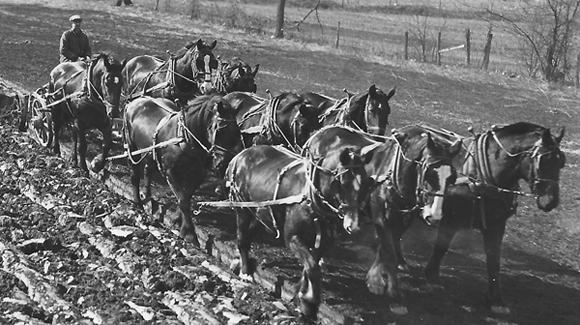
Doc continues, “I remember watching my mentor, Addie, persist over a three-eighths inch adjustment in the point of draft. I couldn't believe he could even see that fine a detail, much less think it made that much difference. But he was adamant about getting it just right. And for Addie, the point of draft was just the starting point. Next he moved to adjusting the angle of draft and then, finally, to the line of draft, getting them all just right. He knew that ensuring the comfort of the horses meant more work, better work and safer work. He not only knew it; he lived it every minute he was with horses and mules.”
The point of draft on the harness is the point where the trace is attached to the hame. This point of draft on the harness needs to be matched to the ideal point of draft on the horse'
s shoulder. Locating that ideal point of draft on the shoulder is the subject of a future article.
Locating the point of draft of the harness over the ideal point of draft on the horse'
s shoulder is a matter of proper collar size and fit and proper hame size and hame adjustment. It’s not as simple as getting a collar that fits the horse and then putting the hames on and expecting the point of draft to be right for the horse. Ideally, the point of draft on the hame should be adjustable; some hames are highly adjustable, while many allow for only minor adjustment.
The point of draft needs to be adjusted just right so that the pull on the collar is distributed across the collar face that lies on the “collar bed/collar shelf” of the horse’s shoulder. Doc explains, “If the point of draft is too high, it’s going to do a couple of things. First, we’re going to be transferring too much of the draft to a smaller surface area of the shoulder that is not as anatomically well suited for the pull. Second, there can be a tendency for the collar to be pulled upward against the windpipe.”
“On the other hand,” Doc continues, “the problem with the point of draft too low is that the forces are being concentrated too low on the shoulder. There, they can interfere with the horse’s stride and cause damage to anatomical structures of the horse
s shoulder joint that don’t have an adequate cushion of muscle to protect them from the forces of the load.”
Regarding the photo on the opposite page, Photo #1, Doc calls attention to where the trace leaves the hames on the horse closest to the camera. “You can see that the trace leaves the hame above the point of the shoulder, so the trace passes over the well-muscled part of the shoulder. While it’s always impossible to tell for sure from pictures, the point of draft on this horse looks pretty good as it does on the other horses in the hitch where you can see it.”
The angle of draft is the angle at which the trace leaves the hame. Visualize the long axis of the hame as a line, and visualize the trace being another line; the angle between those two lines is the angle of draft. For the most efficient transfer of power from horse to load, the angle between those lines needs to be as close to a right angle (90 degrees) as possible. If the angle is different from 90 degrees, Doc cautions that there is the potential for draft activity to cause discomfort to the horse and possibly damage the shoulders. Regarding Photo #1, Doc comments, “The angle of draft on the horse nearest the camera appears close to ideal and the angle of draft on the horse behind him appears to be ideal. Collar sores are not only a result of ill-fitting collars; point of draft and angle of draft are important contributing factors as well.”
The line of draft is how the trace runs from hame to load. The line of the trace should be straight and unbroken, as shown in the photo on the opposite page. Often, though, when loads are closer to the ground, such as harrows, logs or stone boats, the trace carriers or lazy straps on the harness aren’t long enough, and they cause the trace to bend as it passes through them. When in draft, the trace tries to straighten, pulling down on the trace carrier, which in turn pulls down on the horse's hips.
Doc observes, “Few people know this causes problems for horses. They hitch to a load and don’t realize that that the trace carriers on most harness are made to pull vehicles, where the hitch point is elevated rather than being near the ground. I see a lot of people pulling loads on the ground with trace carriers that are too short. They may or may not be having trouble with their horses, but the line of draft is broken, and the potential for problems exists.”
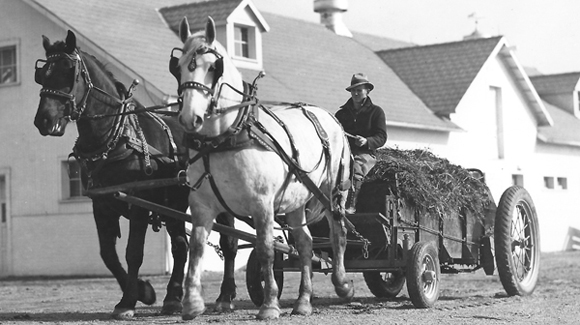
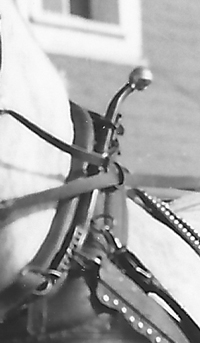
The photo above shows a team of horses on a manure spreader. What do you think about the point of draft on the harnesses on these horses? Doc observes, “If you compare the distance between the point of the shoulder and the collar on the black horse and the point of the shoulder and the collar on the gray horse, you can see that the distance is much greater on the gray horse. This is because the point of draft on the gray horse is significantly higher than it should be. The high point of draft on the gray horse is creating disadvantages for her, as is the fit of her collar.”
Doc continues, “Of course there’s a relationship between collar fit and optimal point of draft. On the gray horse, the collar appears to be too small, especially too short in length. If these collars were fit when the horses weren’t checked up, and then they were checked up, the collars are going to be a lot tighter, and the point of draft is going to be higher. The opposite can be a problem, too. If you fit the collar with the horse’s head up and then they work with it lower, then the collar will be too long and the point of draft will drop. It is extremely important to fit collars to horses when their heads are very close to the average height that they work in order to avoid these problems.”
The close-up of the hames in this photograph shows that an adjustable draft point hame is being used, also called a lonestar hame. Using this sort of hame allows the teamster to adjust where the trace ties into the hame to ensure that the point of draft is correct. Doc notes, “Because the collar doesn’t fit correctly, lowering the point of draft by dropping the traces to the lowest setting on the hames will not solve the problem. The point of draft would still be too high. You’d need a longer collar and longer hames. Then you could set the traces where the point of draft needs to be.”
Doc adds, “The high quality collars we have for horses in this country are artfully designed to fit the anatomy of horses’ shoulders. If we get them to fit properly to protect the shoulder, they give the horse the best advantages of comfort and draft. You need to get the collar fit right first, and then work on the point of draft.”
Photo #3 on page 52 shows a team of mules. The collar on the mule farthest from the camera looks like it fits very well, and the point of draft looks good. On the mule closest to the camera, though, the point of draft is low because of a combination of the collar being too long and the hame being adjusted too low on the collar. Doc says, “Almost everywhere I go, I can show you collars that are too long. Like in Photo #3, that puts the point of draft too low. Then the force of the load is being concentrated too low and can cause damage to skin, tendons, ligaments and bone associated with the shoulder joint.”
Doc continues, “As if collar fit and point of draft aren’t challenging enough, there are also considerations related to the conformation of the horse. The other day I was relationship between collar fit and point of draft. The owner had an adjustable collar. If I adjusted the collar to be the right length, the draft area of the collar where the point of draft needed to be was way too high relative to what the horse’s shoulder needed. If I lengthened the collar to get the draft area of the collar down to where the point of draft should be on the horse, the collar was way too long. It was just this particular horse’s anatomy. Even though I had an adjustable collar, it couldn’t be made to fit the neck and shoulder conformation of that horse. With the other horse in the team, when I got the length of the same collar right, the draft area was just where it needed to be on the shoulder. It all went together easily by comparison. Due to his conformation, the first horse was a rather unusual situation.”
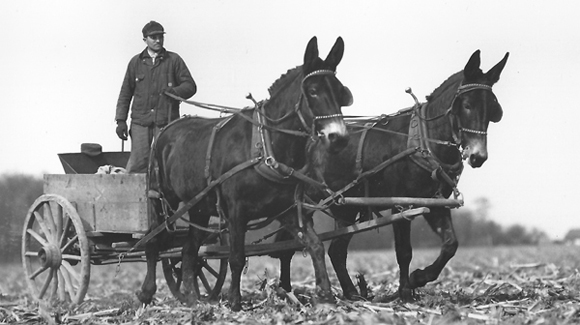
“In most circumstances when we hitch, if the hitch point is a reasonable height, the optimal angle of draft will be easily acquired. If we have a hitch point and have 90 degrees naturally, we want to adjust the belly band and backpad billets to fit where that trace is that way, if we hitch to a hitch point that is too high, and there’s a force wanting to pull the back end of the trace up, it will break the line of draft at the belly bandback pad billet level, but 90 degrees will be maintained forward. In such cases, the line of draft will be broken, which is less than ideal.”
“Another thing I’m watching,” says Doc, “is the hitches using ropeand- pulley systems. With every team that you put out in front of another, the angle of draft gets higher. With wheel teams, the angle of draft is close to correct depending on the height of the hitch point, then the next team in front is pulling on the same hitch point, but they’re further away so it brings the trace up higher on their legs above the hock. If you have a third team out front, then the trace is up closer to the stifle joint. Each team forward is losing draft efficiency, and the angle of draft is distorting the lay of the collar, rotating it and changing the balance of the load on the shoulders.”
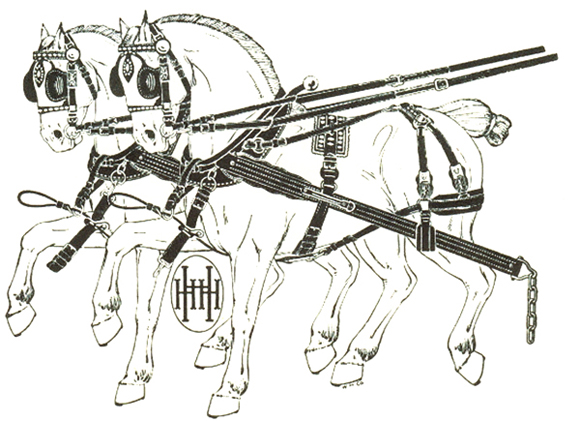
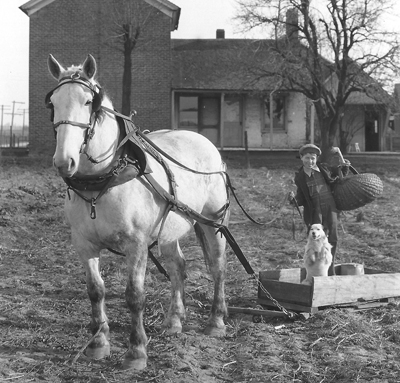
Photo #4 shows the most common manifestation of draft inefficiency. The trace carrier (or lazy strap in a Western type harness) isn’t adjusted long enough, and it is deflecting the trace from being a straight line from hame to load. This horse, of course, isn’t in draft, so the trace will be less deflected when the load is engaged. Nevertheless, the trace will still be deflected upward by the trace carrier, and there will still be an inefficient transfer of power. In addition, with the horse feeling downward pressure on its hips from the trace pulling down on the trace carrier, there may be a balking issue or safety issue if the horse becomes concerned with that feeling of downward pressure, especially in the case of heavier loads.
Doc shares, “I have seen many situations where problems have developed because the line of draft is broken by trace carriers that are too short. Many horses appear comfortable pulling light loads under these circumstances but become balky with heavier loads. I once had a client who had this problem with a mare who would willingly pull a pickup tire on the ground, but, when hooked to a semi tire and wheel, she got balky. The mare would go to the right and to the left trying to evade the downward pressure on her hips, then going forward she’d stop and rear up. I put in trace carrier extensions so that the line of draft wasn’t broken, and, again, she was fine on the pickup tire to warm her up, then I switched to the semi tire and wheel. When she felt the additional weight she didn’t want to go forward. I kept being patient and asking her to go forward; as soon as she found out that the load wasn’t going to put downward pressure on her hips, she walked off with it. Within 10 minutes, I had her pulling me standing on the tire. That mare has been a solid puller ever since.”
In Photo #4, lengthening the heel chains to put the load back further would reduce the deflection of the trace, but it would also decrease the efficiency of draft. The better solution is to lengthen the trace carriers so the trace is free to ride in a straight line from hames to load.
Doc shares, “We worked with four horses in the last several days, three at one place, one at another. As is usual, every one of them had trace carriers that couldn’t be adjusted long enough to pull a load on the ground. As a temporary fix, I carry baling twine, and I take the trace carriers off the breeching rings, make loops of bailing twine on the rings, then let the trace carrier hang at the proper height from the baling twine. Trace carriers/lazy straps are made just long enough for pulling equipment/ vehicles where the hitch point is higher. All other aspects of the harness are capable of pulling loads on the ground, just not the lazy straps/trace carriers.
“Almost all of our clients want to pull things on the ground with their animals. Where they really gain their skill is ground driving and pulling something on the ground. When I’m training young horses, I spend a lot of time teaching them to pull things on the ground, so I am constantly aware of the need to make adjustments to the trace carriers/lazy straps. I wouldn’t use baling twine to temporarily modify a harness just anywhere. The trace carrier isn’t a piece of harness that if it fails is necessarily going to be a problem. The function of the trace carrier is simply to hold the trace up off the ground when the horse is not in draft. Since the trace carrier does not function when the horse is in draft, I feel comfortable using baling twine as a temporary fix.”
Doc adds, “When we help clients order new harness, we make sure the trace carriers/lazy straps have enough adjustment. The only way I know to do that is to have them custom-made with longer straps. Either we have the trace carrier straps made extra long, or we have them extended with an additional strap that can be buckled on to the end of the trace carrier strap then the other end into the trace carrier.”
“Before I can even start contemplating point of draft, angle of draft, and line of draft in this picture,” says Doc, “I have to comment on collar fit. These collars are too small for these horses. They aren’t sitting down on the shoulders. They’re up on the wedge of the neck rather than seated down on the shoulder beds. Those collars are causing compression on the tapered part of the neck, and they’re going to just squeeze like the dickens all the way around the neck and put pressure on the windpipe. These horses are very attentive to what is behind them, but they’re also telling me they’re very uncomfortable; possibly be comfortable?”
Doc continues, “This is a perfect picture to headline the high point of draft. The reason that the point of draft is so extremely high is that the collars and hames are much too small. You can’t bring it down using those collars and hames. You’d need larger collars and longer hames to bring the point of draft down where it needs to be. Even if you lowered these hames down as far as you could on the collar, you still couldn’t get the point of draft where it needs to be. These horses are also checked up uncomfortably high which brings the point of draft up even higher than it would otherwise be. While letting their heads down would lower the point of draft somewhat, it would still be much too high because of the collar fit issues.”
Photo #5 shows another broken line of draft scenario. Doc explains, “The traces are deflected steeply upward as they travel forward from the belly band billets to the hames. This is because the point of draft is extraordinarily high due to the undersized collars sitting so high up on the necks. The solution to this broken line of draft is to solve the high point of draft issue with wellfitting collars and appropriate, properly adjusted hames. Once that is done, if the horses were to step forward into draft, the single trees, the trace chains and traces behind the belly band billets would be pulled upward causing the line of draft to straighten all the way from the new point of draft to the single trees. Then it might be necessary to make adjustments to the back pad and belly band billets, especially on the off horse where the belly band is very loose.”
Doc has some other comments about the harness in Photo #5. “First, you see that there are chains connecting the tongue to the collar. A lot of times these chains were used on stiff-tongued vehicles, tongues that didn’t hinge and drop down to the ground. So the tongue weight was supported by design; the horses weren’t required to hold the weight of the tongue up with the chains. Still, this hitching system is pulling the bottom of the collars towards the tongue and into the outside of the shoulders. You can see how the breast strap is pulling inward, not straight forward as it would be with a neck yoke set up. This causes unequal forces on the inside and outside shoulders of both horses. It can potentially result in discomfort and shoulder soreness, or irritate the horses and cause behavior and safety problems.
“Next you’ll notice that the bridles are different from one horse to the other. The off-horse has some sort of cavesson around his nose, perhaps to keep his mouth shut. It wouldn’t surprise me if all the harness fit and draft efficiency issues weren’t causing behavior problems that prompted the teamster to force his mouth shut. Both horses are also working on leverage bits, one on the most extreme setting and the other on the second. Perhaps the severe bits would be unnecessary if other issues affecting the horses’ comfort were dealt with.”
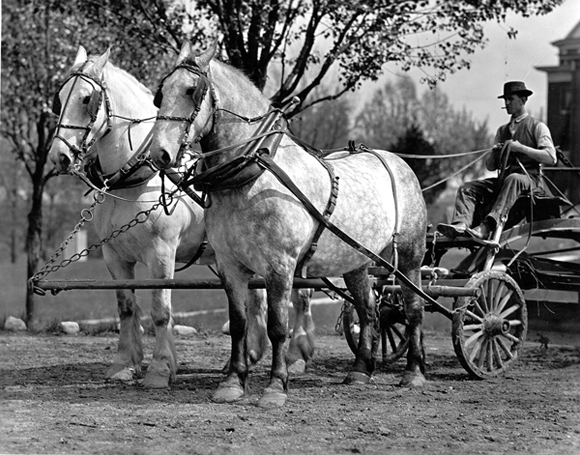
And the line of draft?
